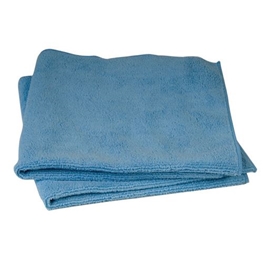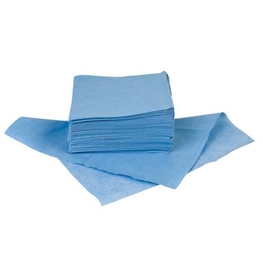Wipe cleanliness is usually determined based on three different parameters:
- A particle count is determined, which measures the size distribution of extractable particles in a wipe sample. Particulate counts are determined by a number of different methods, most of which involve agitating a sample wipe in ultra-pure water or another suitable solvent and measuring the distribution of different sized particles using a particle counting instrument. Particle counting instruments determine the size and distribution of particles using a technique that relies on light scattering. Particles are reported as the particle size distribution from 0.5 microns to 20 microns.
- Cleanroom grade wipes must also be low in extractable non-volatile organic residues. The amount of such residues is determined by extracting the residues from the wipe using ultra-pure DI water, ultra-pure IPA, or the solvent being used in the particular cleaning application.
- The wipe is analyzed for the amount of extractable ionic contaminants present, such as salts and minerals. Since wipes are used in the manufacture of critical electronic assemblies, corrosion due to ionic salt contamination is of concern.
Techspray offers two types of wipes: cleanroom grade wipes and general purpose wipes.
CLEANROOM WIPES
Cleanroom grade wipes are designed and processed to reduce the generation of particulate contamination when used in a critical environment. All cutting, laundering and packaging operations are performed in a manner that eliminates or greatly reduces the introduction of particulates into the product and their subsequent introduction into the critical environment.
Cleanroom wipes are double-bagged, so the outer-bag can be removed in a staging area, and then the inner-bag is wiped down before being brought into the critical environment.
Techspray cleanroom wipes can be used for general cleaning, but are best for use in critical environments, where the amount of particulate contamination is of greatest concern.
Wipes made with synthetic fibers like polyester are the cleanest due to three manufacturing steps that determine consistency and control in the processing of the wipes:
- The composition and contamination level of the wipe fabric is controlled by using pure materials and controlled chemical reactions.
- The fabric fibers are extruded to very long, consistent lengths. A single fiber can stretch continuously from one side of a wipe to the other, minimizing its chance to be lost from the wipe.
- The fabric composition and its processing are designed to achieve the best balance of properties for the finished product.
Cleanroom wipes used for critical applications are almost always knitted synthetic fibers. Knitted polyester fabric, like used for Techclean Purwipe (part #2355-100), is the most popular wipe material for cleanrooms. Knitted polyester is made clean, contaminants can easily be removed from knitted polyester in a cleanroom laundry, and polyester is relatively inexpensive. Non-woven wipes do not offer the advantage of ease in cleaning as their composition causes them to disintegrate in a cleanroom washing machine or cleanroom drier.
Techclean Anti-Static Wipes (#2362-150) are also woven polyester, but include stripes of DuPont’s NEGA-STAT carbon yarn. This prevents static generation, which is especially important when dry wiping. Anti-Static Wipes are packaged in a class 10 cleanroom, so ideal for cleanroom applications. This wipe is widely used on smart phone and pad computer screens in assembly or repair operations. Wiping glass screens with standard polyester will tend to generate static and attract dust.
General Purpose Wipes
Techspray general purpose wipes (e.g. Blue Maintenance Wipes #2365-300) are meant to be used for wiping and in non-critical or controlled environments. By cleanroom standards, Techspray general purpose wipes would be acceptable in Class 10,000 cleanrooms or in “controlled environments”.
TechClean Wiper (2350-100) is a non-woven blend of polyester and cellulose, with the best properties of each. The cellulose gives it good solvency and strong cleaning strength, and polyester it gives it good wet strength and then a high degree of cleanliness. Because of absorbency, strength, and lower cost, TechClean Wipers are commonly used in electronic assembly on SMT stencils for removing solder pastes and adhesives.
For more industrial application, Blue Maintenance Wipes (2359-300, 2364-50, 2365-300) are also made of polyester and cellulose wipes, with all the cleaning advantages of TechClean Wiper at an even lower cost.
Techspray offers a Cotton Cleanroom Wiper (2340-100) as a more eco-friendly option. Like the TechClean Wiper, it is nonwoven and very absorbent, but made of 100% renewable cotton.
TechClean Absorbwipe (2351-100, 2352-100) is made of an ultra-soft nonwoven polyester material that is ideal for delicate surfaces like lenses and fiber optic endface cleaning.
TechClean Twill Wipe (2357-100) is a knit cotton wiper that can handle the high temperatures required in some applications. Whereas synthetic material like a polyester might melt or might degrade with the high temperatures, cotton will hold up well.
Abrasion Resistance
Any wipe will produce particulates depending on the amount of abrasion it receives in use, so abrasion resistance should be considered. Wipes usually release the most particulates from their edges, so using a sealed-edge wipe will greatly reduce the particulate burden. Heat cutting is a common method of creating a sealed edge. A hot knife cuts the edge and simultaneously fuses all the loose ends on the wipe, as in the Techclean Purwipe sealed edge poly wipes.
The texture of the wipe should also be considered when critical or sensitive surfaces are involved in the application. Some wipes can abrade some critical coated optical surfaces and should therefore be avoided in such applications.
The Techspray Microfiber Wipes have superior surface contact capabilities due to the unique wedge shape of their fibers, which act like tiny squeegees in scraping and lifting residues from surfaces. The Microfiber Wipes (#2363-150) also have high solvent absorbency and excellent particle entrapment. Their high strength allows them to be laundered a number of times and re-used (NOTE: avoid fabric softeners). Their extreme softness and texture make them the wiper of choice when cleaning sensitive optical surfaces.
Solvent Compatibility
Solvent compatibility is another factor to consider when choosing a wipe. If the wipe is to be used with a solvent in the cleaning application, then the wipe must be selected with the solvent in mind. Solvent retention and absorbency may also be required. The wipe must the able to absorb a given solvent and retain the solvent within the fabric of the wipe for a sufficient amount of time, without premature release of the solvent.
Knitted polyester and nylon wipes have the highest compatibility with a wide range of organic solvents and weak acids. Techclean Purwipes and Anti-Static Wipes have good absorbency, excellent durability when cleaning rough surfaces, and low ionic and organic residue contamination.
The polyester/cellulose blended Techclean Wiper and Blue Maintenance Wipes have excellent resistance to solvents and weak acids, good durability when cleaning rough, abrasive surfaces, high particle entrapment and low particle and ionic contamination. They are an economical choice for general cleaning and spill clean-up.
For more information, contact a Techspray technical specialist at techspray@itw-cc.com or +31 088 130 7400.







